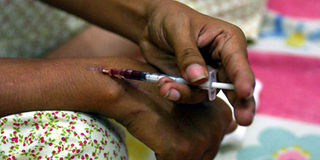Policy to shield drug users against HIV

A heroine user. FILE PHOTO | CHOO YOUN-KONG | AFP
What you need to know:
- Uganda’s Ministry of Health is piloting a needle exchange programme in five referral district hospitals as Burundi MPs committed to support the relevant legislation.
- Lack of action and weak policies have further occasioned a constant state of denial.
- The number of injecting drug users has increased.
Drug use in East Africa has risen phenomenally over the past few years, courtesy of international cartels that have turned the region into a major narcotics transit route.
Consequently, the number of injecting drug users has increased. These have been linked to new HIV and Hepatitis C infections, piling pressure on the region’s inadequate healthcare systems. With the persistent increase of the infections in sub-Saharan Africa, policy makers have begun a drug policy dialogue as leaders consider shifting focus to approaches based on evidence and embrace public health and human rights perspectives in tackling the drug menace.
Collectively, these approaches form the concept of “harm reduction”, which projects drug abuse as a public health issue with users deemed to be in need of medical assistance and not punishment. For instance, Uganda’s Ministry of Health is piloting a needle exchange programme in five referral district hospitals as Burundi MPs committed to support the relevant legislation.
The region’s MPs have come together under the Global Fund regional grant fronted by KANCO-Kenya and declared unequivocal support for such legislation.
Eastern Africa is characterised by a generalised HIV epidemic — whose main mode of transmission is sex — that is disproportionately severe among people who inject drugs.
DRUG POLICIES
Inasmuch as drug policies have focused on supply reduction and law enforcement, the legal environment is blind to the public health reality that people who inject drugs are vulnerable groups with high-risk behaviours. Indeed, most have overlapping relationships with other key populations that play a significant role in HIV epidemics. Due to limited research, most regional policy makers possess limited knowledge on trends and impacts of unsafe injecting drug use and related risks. Lack of action and weak policies have further occasioned a constant state of denial.
This has limited homegrown interventions to support healthcare access. For instance, across the board, legal and policy environments continue to criminalise possession of needles and syringes despite the obviously negative impacts. Fear of arrest and harassment by law enforcement agencies also pose obstacles for such people.
As a result, KANCO together with the East Africa Community (EAC) have embarked on an ambitious process to formulate a joint regional draft policy on harm reduction services for people who inject drugs.
Experts drawn from the five EAC member states have been meeting since May 2016 to deliberate on the draft policy ahead of further consideration and validation by the East African Legislative Assembly.
PUBLIC HEALTH PROBLEM
East Africa would be the first region on the continent to formulate such a policy, to be known as the EAC Regional Policy on Harm Reduction Services for People Who Use Drugs (PWUD).
The policy is intended to guide EAC states in responding to drug use as a public health problem — and build on lessons and experiences of harm reduction services. Besides informing the actions of policy makers, health workers and law enforcement officials, it also seeks to customise EAC’a approach and commitment to harm reduction.
Measurable objectives
The policy further seeks to promote and ensure access to comprehensive, evidence-based harm reduction services for PWUDs — thereby reducing the levels of drug-related health and social harm experienced by these individuals and their families and communities. This is in line with the EAC HIV & Aids, TB and STI Multi-Sectoral Strategic Plan and Implementation Framework 2015-2020.
MEASURABLE OBJECTIVES
Behind the over-arching goal, the policy contains a series of measurable objectives that relate to areas covered by EAC in the health strategic plan, which are to support, promote and collate national-level research regarding PWUD and drug-related harms and also to promote the adoption of domestic harm reduction policies.
It also seeks to ensure the delivery of sustainable, quality, comprehensive harm reduction interventions for PWUD — including tailored services for women who use drugs and other groups in need; strengthen the capacities, awareness and capabilities of stakeholders to support the development and implementation of cost-effective harm reduction programmes and to promote supportive legal, policy and social environments.
Once validated by the Eala and domesticated by EAC member states, the policy will, definitely, make the fight against drug abuse and addiction more humane while according those addicted more protection against HIV infection.
Ms Apondi is the regional policy manager, KANCO-Kenya. [email protected]. Twitter: @apondibernice




